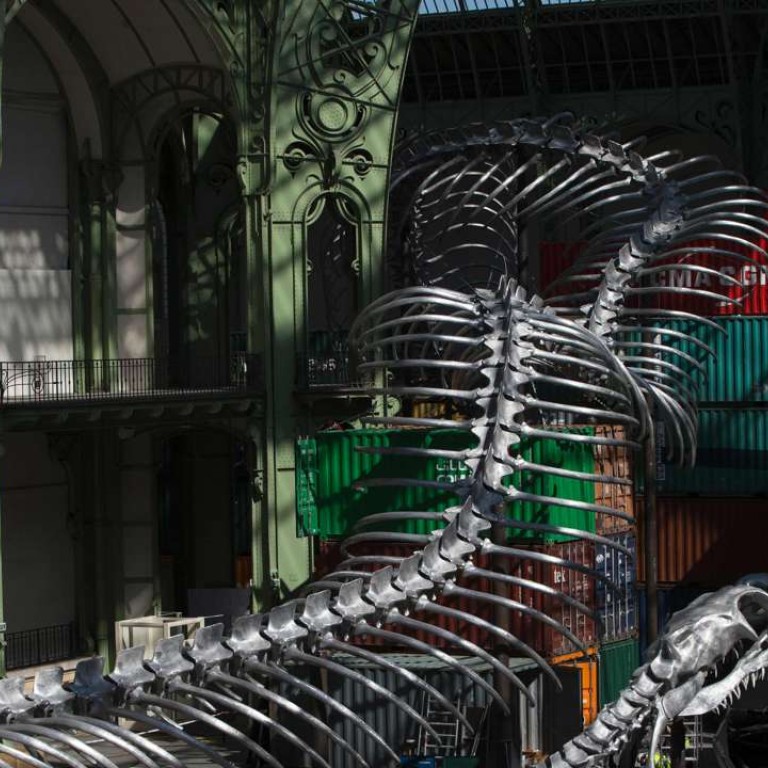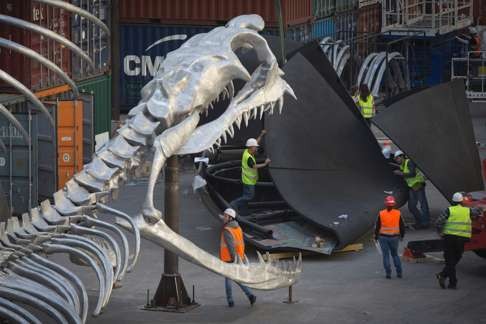
China a snake about to eat the West in exiled artist’s monumental Paris show
Huang Yongping’s giant serpent, its jaws agape, threatens a triumphal arch of shipping containers - symbol of global capitalism – in Empires, huge work at the French capital’s Grand Palais
Monumental modern art doesn’t come much more spectacular than this. The finishing touches were being put late last week to a breathtaking installation about power by Chinese artist Huang Yongping, which has a 133-tonne snake threatening a triumphal arch made from shipping containers topped with a giant Napoleon hat.
This show has an ambition that you will not see in many places in the world
It is easy to see “Empires” - which opened to the public on Monday - as a metaphor for China’s massive economic muscle dethroning the old great powers of the West. But the artist best known for putting scorpions, tarantulas and other creepie crawlies in a glass case and letting them fight it out in his controversial Theatre of the World, says “there are several levels” to his enormous new show.
“It is about history, art and philosophy too,” he says, adding that he also wanted it to have a wow factor for “the general public”.

Curator Jean de Loisy says it is one of the most spectacular works ever shown in France’s annual Monumenta show, when an artist is given free rein of the vast, domed Grand Palais in Paris.
“Nothing has changed the world more in the last two decades than the internet and shipping containers. They are the motors of global capitalism,” he says.
“This show has an ambition that you will not see in many places in the world,” says De Loisy, who runs the Palais de Tokyo modern art museum in the French capital.
He says the show confronts people with the enormity of the forces shaping our world.
“The moment you walk in you are faced by a huge cliff of containers, stacked seven high, which shows how small we are in relation to global industrial power,” the curator says.

He says Huang had created a “complete symbolic landscape” with the giant skeleton of a 254-metre-long snake wrapping itself around the containers, its fanged head menacing Napoleon’s bicorne hat – an exact, scaled-up replica of the one he wore at the Battle of Eylau in 1807 when he was at the peak of his power.
“It was the battle that most shook Napoleon because of the huge number of dead,” explains De Loisy. “In that moment you sense the vulnerability of his supremacy.”
The five-metre-high hat faces Les Invalides where the general is buried, and also lines up with the seat of French presidential power, the Elysee palace.
But it is clearly slipping from the top of its arch of containers, the curator pointed out, under the threat from the snake – which he said symbolises change and the crushing power of capitalism.

“The snake with its aggressive head is the power of industry on the march, of geo-economic forces... China has made the choice of global economic power while America has made the choice of military might,” De Loisy says.
He s says Huang makes no “moral judgements” about the system which sees “containers making the great fortunes of the world but also providing a hiding place for the most unfortunate, the migrants who are smuggled in them”.
“This ambivalence is crucial,” he says. “We can do no more about the forces shaping our world in his view than you can about tectonic plates bumping up against each other or a volcano erupting.”
Huang also arranged the containers in a nod to the traditional Chinese board game of mahjong.
“He feels the relationship between the West and China is also comparable to that between (the game of) Go and chess, symbolised by Napoleon’s hat – which is why we don’t understand each other well enough.”
Huang left China for France at the time of the Tiananmen protests in 1989. “Empires” runs until June 18.

.png?itok=arIb17P0)